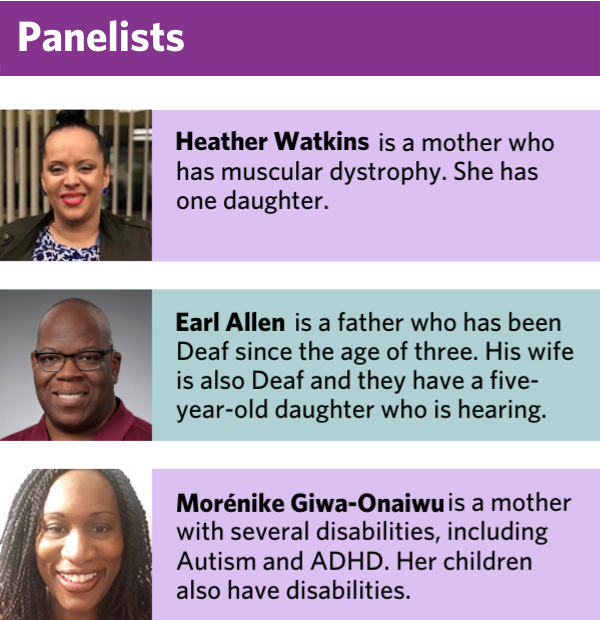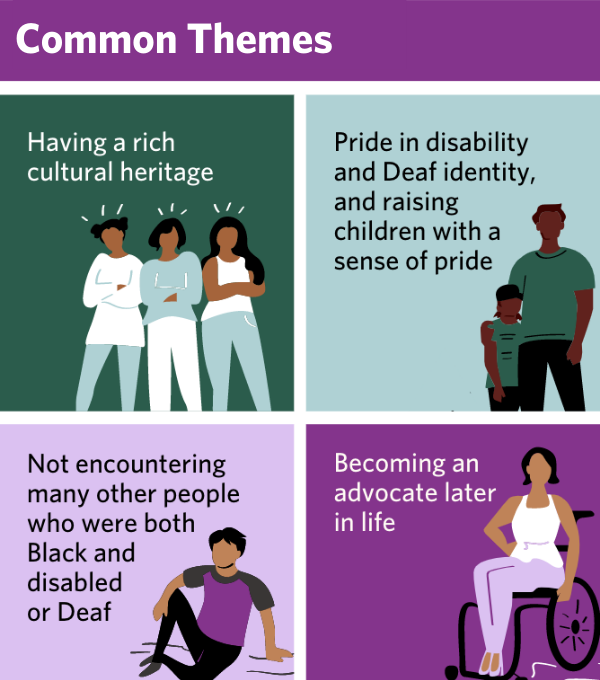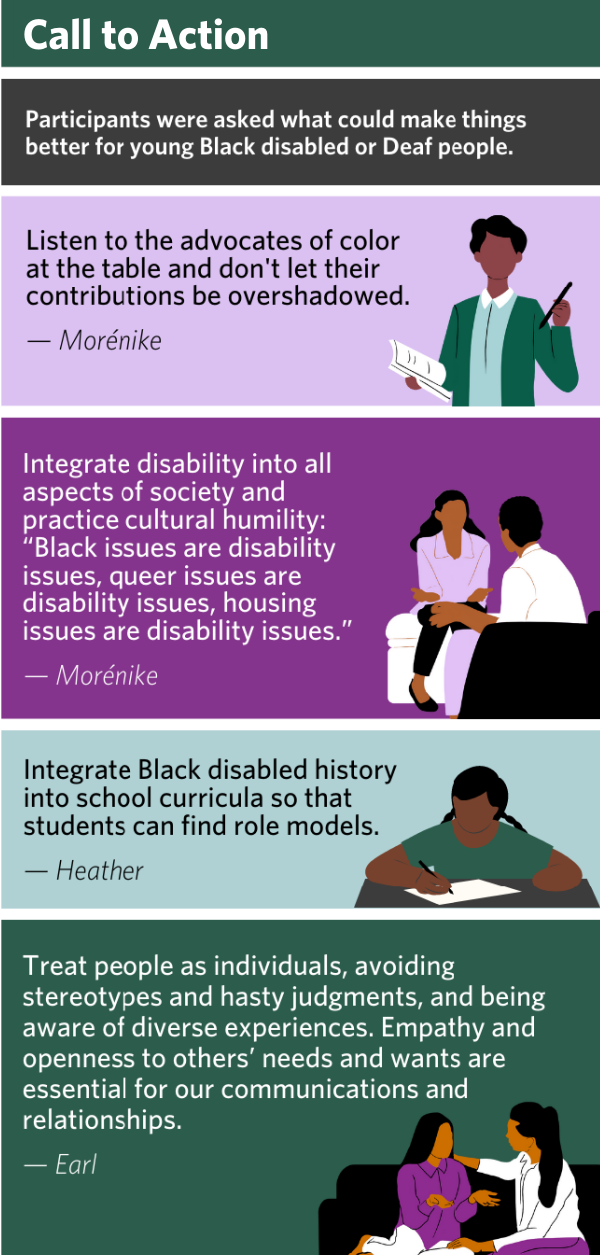Black, Disabled, Deaf, & Proud
Webinar Recap · April 2022
Access the Webinar Recording | Download the Webinar Summary PDF
Panelists
 Our panelists comprised Heather Watkins, Earl Allen, and Morénike Giwa-Onaiwu. Heather is a mother who has muscular dystrophy. She has one daughter. Earl is a father who has been Deaf since the age of three. His wife is also Deaf and they have a five-year-old daughter who is hearing. Morénike is a mother with several disabilities, including Autism and ADHD. Her children also have disabilities.
Our panelists comprised Heather Watkins, Earl Allen, and Morénike Giwa-Onaiwu. Heather is a mother who has muscular dystrophy. She has one daughter. Earl is a father who has been Deaf since the age of three. His wife is also Deaf and they have a five-year-old daughter who is hearing. Morénike is a mother with several disabilities, including Autism and ADHD. Her children also have disabilities.
Recalling Cultural Understanding of Disability
Morénike recounts that in her family disability was thought of as “you being helpless, of you being … unable to do things, and not having independence and autonomy.” Heather’s family also saw disability through a “lens of limitations.” Though her grandmother, a source of great wisdom, was the first to notice that Heather was having motor issues, she would consider Heather “handicapped but healthy.” Both women remembered that disability “wasn’t something that you embraced.”
The Impact of Representation
All three participants noted challenges from not being around people who share all of their identities, especially when growing up. However, at one point Earl had a Deaf school counselor who was Black. In stark contrast to the counselor he worked with in college—to whom “I had to explain so much about myself before we could even get started”—Earl could more easily communicate with his earlier counselor about what was going on in his life “because I was able to see myself in him and he was able to explain Deaf culture and how he dealt with it growing up.”
Discussing Identity and Intersectionality
The panelists discussed the intersectionality of their disability identity with their racial identities, with disability being another identity associated with stigma. Heather stated: “It takes us a bit longer to identify in the Black community that way because of stigma, religion, culture, community.” For Morénike, it’s “not about having a disability per se” but “having yet another thing that you had to code switch, or hide, … in order to be accepted.”

Common themes that emerged were having a rich cultural heritage; pride in disability and Deaf identity and raising children with a sense of pride; not encountering many other people who were both Black and disabled or Deaf; and becoming an advocate later in life.
While people with marginalized racial, religious, or sexual identities are increasingly self-accepting, despite some stigma, Morénike noted that this is less common with disability. At times, too, “because of the intersection of race and disability … either your racial identity is erased in favor of … emphasizing your disability or the other way around.”
Disclosing a disability comes with risks, such as loss of custody of one’s children, exclusion from educational opportunities, and lack of career advancement or professional development, especially for disabled people of color. Earl noted that as a Deaf Black man, getting pulled over by police while driving could lead to terrible consequences from not being able to follow verbal instructions.
Becoming an Advocate
Both Morénike and Heather recounted becoming disability advocates somewhat later in life. Both mentioned their children as part of their acceptance and advocacy. Their children depended on them to show strength and confidence. Some of their children shared their parent’s disabilities and without acceptance and advocacy, they might not easily thrive.
Pride and Parenting
All three panelists discussed raising their children to feel pride in all of their identities and/or to be immersed in the disabled community.
Earl’s young daughter, who is not Deaf, is learning more American Sign Language so that she knows both the Deaf and the hearing worlds. He added: “I do feel pride in being a Deaf person. I do feel pride that I don’t allow being Black or being Deaf to make me feel lesser in any way because it’s who I am.”
Heather is conscious of setting an example for her daughter of how to find her passion and work on meaningful contributions to her community. Heather stressed how much “nuance, range, and complexity” there is in the Black disabled and Deaf community, which allowed her to understand herself as “a person in need of care, a caregiver, and a community builder all at once. And if you redact any part of that bio then you reduce our contributions to the community.”
Call to Action
 Participants were asked what could make things better for young Black disabled or Deaf people.
Participants were asked what could make things better for young Black disabled or Deaf people.
Morénike stressed the need to listen to advocates of color who are at the table and not let their contributions be overshadowed. She also called for the integration of disability into all aspects of society and for the practice of cultural humility. "Black issues are disability issues; queer issues are disability issues; housing issues are disability issues," she said.
Heather pointed to the need to integrate Black disabled history into school curricula so that students can good find role models for themselves. And Earl emphasized how people must be treated as individuals. People should avoid stereotypes and hasty judgments about others, and be aware of diverse experiences that differ from their own. Empathy and openness to others' needs and wants are essential for our communications and relationships with others.
